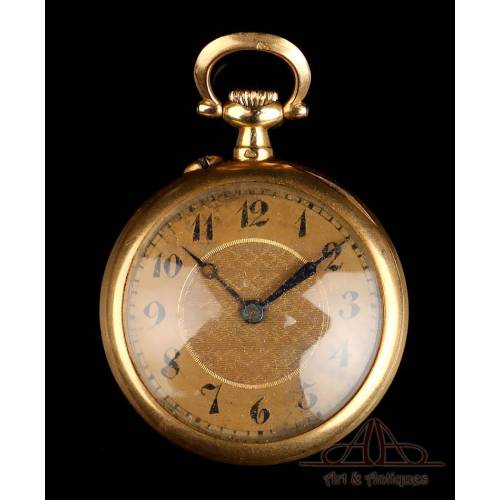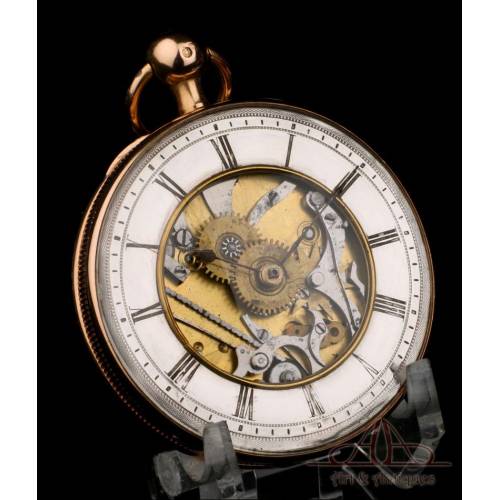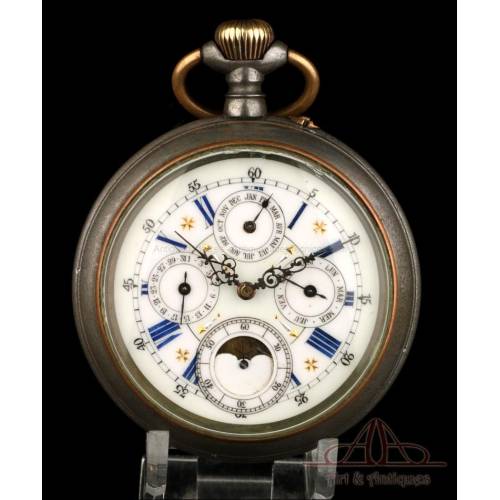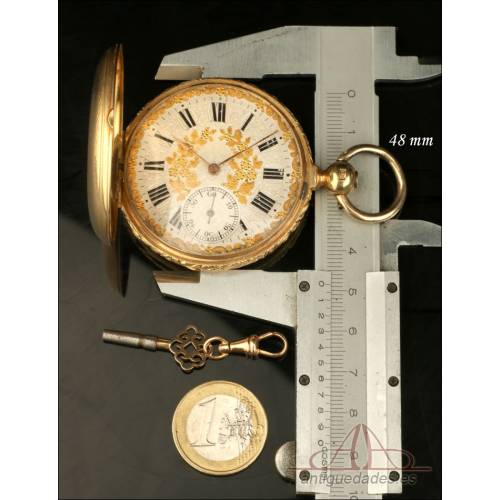Antique Pocket Watches
Antique pocket watches make up an exciting universe that includes authentic jewels made of precious materials, but also simple models full of charm and authenticity. In the days when wristwatches were still unknown, pocket watches were an indispensable accessory for measuring time. They were also elegant accessories that gave a glimpse of the s...
Antique pocket watches make up an exciting universe that includes authentic jewels made of precious materials, but also simple models full of charm and authenticity. In the days when wristwatches were still unknown, pocket watches were an indispensable accessory for measuring time. They were also elegant accessories that gave a glimpse of the social class and style of the wearer. Today, the fascination with antique pocket watches continues to live on: literary and aesthetic subgenres such as steampunk. which bases its imagery on the clocks, gears and mechanical contraptions of Victorian England and Jules Verne's France, have revived interest in these wonderful items. On the other hand, for any watch collector the pocket watch models arouse a very special interest, being highly sought after among experts.
History of antique pocket watches
The origins of the pocket watch can be traced back to the 15th century. They were then known as "portable watches" and their construction was made possible after the invention of the spring mechanism (coil spring). They were originally cylindrical or ovoid in shape, like the famous "Nuremberg eggs": slightly elongated spherical clocks, designed by the watchmaker Peter Heinlen in the 16th century in the city that gives them their name. During the 16th and 17th centuries, pocket watches were made in curious and whimsical shapes: animals, skulls, crosses... However, their mechanisms were not very precise. Moreover, they were luxury items intended only for the wealthy classes.
In the 18th century manufacturing was becoming cheaper and pocket watches became more affordable. As Adam Smith points out in his book The Wealth of Nations,at this time "a pocket watch which [...] could be purchased for twenty pounds, can now be purchased for twenty shillings". Already in the nineteenth century, the figure of the American Aaron L. Dennison is revealed as fundamental, to achieve mass production of such items through the company he founded in 1850 with Edward Howard. This company would later be known as the Waltham Watch Co, a pioneering firm and one of the leaders in the sector. After World War I, wristwatches began to replace pocket watches; however, to this day these models are still manufactured because of the enormous attraction they arouse.
Types of antique pocket watches
Among the many antique pocket watches that have survived to our days we find models with gold, silver, platinum, nielloed silver, silver-plated or gilded metal cases... There are also simple designs with plain covers and watches with elaborate decorations, engraved or inlaid. The watch case may have two, three or even four covers; some models include a dust cover that protects the mechanism, hidden behind the back cover. Antique silver and gold pocket watches usually have contrasts and marks that provide information about the country of manufacture, the goldsmith or silversmith, the weight of the silver or the karat of the gold. Gold or silver-plated pieces used to be marked with the word METAL.
High complication pocket watches. Unlike watches with simple mechanism, high complication watches include calendars, moon phase indicators, stopwatches and other devices along with the classic dial and seconds hand. They are high-quality models, highly appreciated among experts.
Antique pocket watches saboneta. The name derives from a French word meaning "little soap". These are the classic pocket watches with a front cover, which protects and covers the glass cover of the dial. To look at the time you have to press a button that opens the cover.
Antique pocket watches lepine. Unlike the saboneta watches, the lepine ones do not have a front cover. The dial is protected only by the glass panel. They are named after the French watchmaker Jean-Antoine Lepine, who in the 18th century created a special mechanism that made it possible to manufacture much flatter pocket watches.
Antique "miner's" pocket watches. In these watches the dial appears divided into 24 hours, which allows you to know what time it is and whether it is day or night. Also called "24-hour clocks", the name miner's comes from the work they do in the dark, where it is impossible to know whether it is day or night.
Antique pocket watches unfold hundreds of possibilities for the collector of special pieces. To start a collection is to step into an exciting adventure, where beauty goes hand in hand with precision and mechanical engineering.
Vintage Nicolet N. Pocket Watch. 18K Gold. 5-Minute Repeater. Switzerland, Circa 1960 Vintage Nicolet N. Pocket Watch....
Gorgeous Nicolet N pocket watch with 5-minute repeating movement. Dial with central opening to show the movement. In working order. Gorgeous Nicolet N pocket watch with...
SoldAntique Fix Watch Minute Repeater Pocket Watch. Switzerland, Circa 1900 Antique Fix Watch Minute...
Beautiful 18K pocket watch with minute repeater. Made in Switzerland for the Spanish market. In working order. Beautiful 18K pocket watch with...
SoldBeautiful Antique 18K Gold Pocket Watch. Switzerland, Circa 1930 Beautiful Antique 18K Gold...
Gorgeous ultrafine 18K gold watch with engraved box. In working order. Dial with central decoration. Gorgeous ultrafine 18K gold watch...
1 700,00 €Extraordinary 18K Gold Detent Pocket Watch. Switzerland, Circa 1880 Extraordinary 18K Gold Detent...
Awesome gold detent pocket watch with striking decoration. In very good condition and working order. Exceptional movement. Awesome gold detent pocket watch with...
SoldAntique Ladies Pocket Watch with 3-Colored 18K-Gold Casing. France, Circa 1900 Antique Ladies Pocket Watch...
Original 18K gold ladies watch with beautiful applied decoration. Three colors. In working order. Original 18K gold ladies watch with...
SoldAntique Ladies Pocket Watch. 18K Gold. France, Circa 1870 Antique Ladies Pocket Watch....
Elegant solid-gold ladies pocket watch. With hallmarks. Cylinder-escapement movement with 8 rubies. Elegant solid-gold ladies pocket...
SoldAntique 18K Gold Skeletonized Quarter-Repeating Verge Fusee Pocket Watch. France, 1820 Antique 18K Gold Skeletonized...
Rare 18K-gold skeletonized verge fusee pocket watch. With quarter-repeating movement and siler dial. In working order. Rare 18K-gold skeletonized verge...
SoldAntique Verge-Fusee Pocket Watch with Leton Enamel. France, Circa 1800 Antique Verge-Fusee Pocket Watch...
Fine antique enameled verge-fusee pocket watch signed by Leton. In good condition and excellent working order. Fine antique enameled verge-fusee...
1 500,00 €Rare Antique Pocket Watch with Calendar and Moon Phases. 64 mm. Switzerland, Circa 1890 Rare Antique Pocket Watch with...
Elegant and rare pocket watch with calendar and moon phases. Made in the late 19th century. In working order. Elegant and rare pocket watch with...
820,00 € 940,00 €Antique Solid Silver Waltham Pocket Watch. USA-England, 1912 Antique Solid Silver Waltham...
Elegant antique silver pocket watch by Waltham. With hallmarks in different parts. In fine working order. Elegant antique silver pocket watch...
395,00 € 450,00 €Rare Antique Pocket Watch with Calendar and Moon Phases. 67 mm. Switzerland, Circa 1890 Rare Antique Pocket Watch with...
Rare big-sized pocket watch with calendar and moon phases. In fine condition and fine working order. Rare big-sized pocket watch with...
850,00 € 950,00 €Antique Verge Fusee Pocket Watch. Calendar and Central Seconds Hand. France, 1820 Antique Verge Fusee Pocket...
Charming verge fusee pocket watch with hand-painted dial. With calendar and secondary hand. In fine condition. Charming verge fusee pocket watch...
1 350,00 € 1 800,00 €Antique Silver Pocket Watch Chain. Enamel Decoration. 19th Century Antique Silver Pocket Watch...
Fine solid-silver pocket watch chain. Adorned with enameled silver barrettes. Complete. Fine solid-silver pocket watch chain....
225,00 € 340,00 €Antique Solid-Silver Pocket Watch Chain. 19th Century Antique Solid-Silver Pocket...
Antique solid-silver pocket watch chain with black enameled details. In fine condition. Hand-engraved winding key. Antique solid-silver pocket watch...
225,00 € 290,00 €Antique English French Royal Exchange 18K-Gold Pocket Watch. England, 1842 Antique English French Royal...
Magnificent 18K gold pocket watch with original key. Signed by French on the machinery. Working perfectly. Magnificent 18K gold pocket watch...
4 200,00 € 4 500,00 €
New products
-

Antique ivory and silver plated stethoscope, late 19th century
Antique stethoscope from the late 19th century in silver-plated metal...
-

Vintage pendant with shell cameo of Jesús del Gran Poder, carved c. 1970
Vintage pendant with a shell-carved cameo of Jesus del Gran Poder, circa...
-

Antique Roman Style Gilded Silver Chalice with Paten. France, 1932
Antique Roman-style chalice in gilded silver with paten. France, 1932....
-

Beautiful Antique 18 K Gold Ring with 7 Natural Diamonds
Antique 18K gold ring with 7 natural diamonds. Delicate openwork design,...
-

Antique Silver Reliquary. José Vilaplana. Valencia, Spain. Circa 1920
Impressive repoussé silver reliquary by José Vilaplana, Valencia, c....
-

Vintage 18K Gold Ring with 7 Natural Diamonds
Vintage 18K gold ring with seven natural diamonds in floral setting....
-

Antique Silver Chalice. Enameled Crosses. Valencia, Spain, 1942
Spanish chalice from 1942 in solid silver, gifted by the Church of...
-

Antique Silver Chalice and Paten. Granada Spain, circa 1900
Spanish chalice in white silver with matching paten, handcrafted....
Specials
-

Amazing Antique Verge-Fusee Pocket Watch. Silver. 62 mm. Milden, Liverpool, UK, 1835
Exceptional silver verge-fusee watch...































